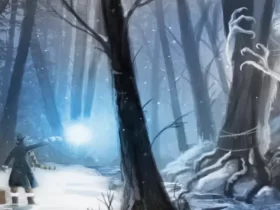The Amazon region of Peru is the site of many unusual and fascinating stories, but few are as intriguing or hold as much cultural importance as the legends surrounding the Yacumama. The indigenous witnesses claim to have seen the Yacumama feeding and report that it creates huge splashes of water while taking down its prey. Some fishermen and their boats have vanished, and others say they heard a terrifying noise after its disappearance, indicating that the Yacumama has consumed her victim.
Appearance

According to local lore, the Yacumama is a massive serpent, reaching up to 60 meters in length, residing in the Amazon River basin. Shamans of the region claim that the Yacumama frequents a place known as the Boiling River. In the stories, the Yacumama is portrayed as the originator of all aquatic life and is said to possess the power to absorb any living being that comes within 100 steps of it. Before entering the river, locals would blow a conch shell horn as a precaution, believing that if the serpent was nearby, it would reveal itself upon hearing the sound.
The Yakumama, also known as “Mother of the Waters,” is one of three legendary serpent mothers from the Peruvian Amazon. She is seen as a super-sized and empowered version of the anaconda, similar to how the Sachamama represents an amplified boa constrictor. In local legends, Yakumama is depicted as a giant anaconda with blue scales and eyes that shine like the lights of a boat. This same creature in the Brazilian version is known as Cobra Grande or Boíuna.
Famous Sighting

In the early 1900s, two men set out on a boat with the aim of using explosives to smash the Yacumama. After the explosive was detonated, the serpent emerged from the river covered in blood, but still alive. The sight of the wounded, but not defeated, snake left the men with a deep sense of fear and awe.
Similar Variations Of Yakumama
- Yacumaman
- Puragua
- Anaconda
Related Reads: Ninki Nanka: Facts About Dragon-Like Monster
Powers And Abilities

The Yakumama is often said to be found lying on the banks of the river, with her tail extending into the water. Her gaze has the power to captivate prey, drawing them towards her with irresistible force. When pleased, she is said to bless people with an abundance of rain and fish. However, she can become angry without warning, causing storms, fogs, and dangerous whirlpools, as well as using her massive size to cause destruction. At times, she is said to consume all the fish and make it impossible for fishermen to catch them, or rise into the sky and bring downpours that damage crops. To appease her, offerings of food and aguardiente are made.
Legends & Myths Of Yakumama
After working in the forest for many years, a man decided to return to Iquitos with his family, servants, lumber, and livestock. He set out down the Napo River on a large boat, but a storm soon broke out. Despite warnings from local fishermen that Yakumama was near, the man pressed on and got caught in a whirlpool. Despite prayers to God, the man threw food and aguardiente into the water, which eventually calmed the whirlpool. He then entered a dense, bluish fog that other animals avoided. The storm raged on until a giant wave lifted the boat and stuck it in the branches of a capirona tree. At that moment, they saw Yakumama rising from the river, with water flowing off her shimmering coils as yaras rode on her back, laughing at the humans. Yakumama started to consume the lumber, cargo raft, livestock, several trees, and an island before returning to the water. The man, who had lost his life’s work, limped back to the native village with his family. He was greeted warmly and offered food and a place by the fire, where he was told about the ever-changing Yakumama.
The widespread use of outboard motors and big ships has caused Yakumama to retreat and she is now rarely seen.
Nowadays, she may be encountered in any river or bay in the Peruvian Amazon, and reports of sightings as well as mysterious disappearances persist till this day.
Similar Legend Of Sachamama
There is another tale of a giant snake. According to some sources, it predates the Yacumama. The Sachamama’s story begins similarly, but it features an indigenous hunter instead of a fisherman. He ventures deep into the jungle in search of food for his tribe. The weather changes and it starts to rain and get dark, so the hunter builds a campfire. Suddenly, the ground trembles as if a minor earthquake had occurred, causing the hunter to become uneasy and extinguish the fire.
The legend of Sachamama features a native indigenous hunter who travels deep into the jungle to find food for his tribe. The weather changes and he starts a bonfire, but the earth shakes and the hunter becomes frightened, extinguishing the fire. The next day, he comes across a giant tree-trunk that blocks his path and a deer that walks toward the trunk before disappearing into it. The hunter realizes that the trunk is actually the body of a giant serpent with a demonic-looking head and a large open mouth.
The hunter, lucky to have survived the encounter, goes back to his village and shares his story, which quickly spreads throughout the region. Over the years, the legend of the Sachamama continues to be told and her presence, lying dormant for centuries at a time, entrapping hunters and animals with her trance-like state and open maw that resembles a jungle cave, while her body is disguised as the trunk of a large tree, surrounded by the bones of previous victims. But if something or someone happens to disturb her, she comes to life.
Theory Of Titanoboa & Yakumama

Some experts think that the Yacumama could be the long-extinct snake species known as Titanoboa, which was known to reach around 12 meters in length. Some scientists believe that it may have grown to an even larger size.
Must Read: 10 Famous Mythical Dragons Of Water From Different Mythologies
Wrapping Up
The legends of the Sachamama and Yacumama are rooted in the pre-Columbian beliefs of Amazonian tribes, with their names meaning “Mother of the Earth” and “Mother of the Water” respectively in the indigenous language. These big sized serpents of land and water play a significant role in both traditional and contemporary Amazonian art and culture and have been present throughout all recorded periods of Peru’s history. One interesting story about the Sachamama dates back to the rubber boom era in Loreto. Today, the legend remains alive and well, with numerous hotels, establishments, tour companies, and restaurants named after the giant serpents and even monuments dedicated to them. In the city of Pucallpa, it seems like everyone either has seen or knows someone who has seen a Yacumama.
References
- von Tschudi, J. J.; Ross, T. trans. (1847) Travels in Peru during the Years 1838-1842. David Bogue, London.
- Galeano, J. G.; Morgan, R. and Watson, K. trans. (2009) Folktales of the Amazon. Libraries Unlimited, Westport.
- Stiglich, G. (1913) Geografia Comentada del Peru. Casa Editoria Sanmarti, Lima.





